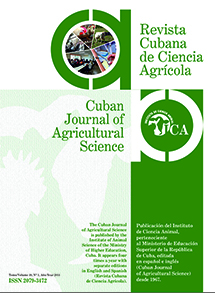Use of agroindustrial residues for producing enzymes by Bacillus subtilis E
Main Article Content
Abstract
Wheat bran, sugar cane bagasse, rice husk and corn stubble were evaluated as substrates for the production of endocellulases, endoxylanases and mannanase by Bacillus subtilis E44 during solid state fermentation (SSF). The SSF was carried out in 250 mL flasks with 1g of substrates, enriched with minimal salts medium, and incubated for 24 hours at 37 °C. The extraction of the enzymatic crude was carried out by the addition of 0.02 mol L-1 sodium phosphate buffer, pH 7.0 (1:10 w/v) in a shaker at 110 rpm for 30 min. Enzyme production was evaluated by measuring enzyme activities in the crude. Based on results, wheat bran, sugarcane bagasse and corn stubble can be used to produce endocellulase, endoxylanase and mannanase, while rice husk cannot be used to obtain endocellulase. Endoxylanase production was superior to the rest of the enzymes and the best inducer was wheat bran (25.08 IU.mL-1), followed by sugarcane bagasse (9.32 IU.mL-1). Rice husk and corn stubble showed values of 6.92 IU.mL-1 and 6.95 IU.mL-1, respectively. Results demonstrated the potential of wheat bran, sugarcane bagasse and corn stubble to produce endocellulase, endoxylanase and mannanase. Rice husk is not a good inducer to obtain endocellulase. Bacillus subtilis E44 demonstrated to be a better producer of endoxylanase enzymes than mannanase and endocellulase.
Key words: endocellulases, endoxylanases, mannanases, solid state
fermentation
Article Details
Those authors that have publications with this journal accept the following terms:
1. They will retain their copyright and guarantee the journal the right of first publication of their work, which will be simultaneously subject to the License Creative Commons Attribution-NonCommercial 4.0 International (CC BY-NC 4.0) that allows third parties to share the work whenever its author is indicated and its first publication this journal. Under this license the author will be free of:
- Share — copy and redistribute the material in any medium or format
- Adapt — remix, transform, and build upon the material
- The licensor cannot revoke these freedoms as long as you follow the license terms.
Under the following terms:
- Attribution — You must give appropriate credit, provide a link to the license, and indicate if changes were made. You may do so in any reasonable manner, but not in any way that suggests the licensor endorses you or your use.
- NonCommercial — You may not use the material for commercial purposes.
- No additional restrictions — You may not apply legal terms or technological measures that legally restrict others from doing anything the license permits.
2. The authors may adopt other non-exclusive license agreements to distribute the published version of the work (e.g., deposit it in an institutional telematics file or publish it in a monographic volume) whenever the initial publication is indicated in this journal.
3. The authors are allowed and recommended disseminating their work through the Internet (e.g. in institutional telematics archives or on their website) before and during the submission process, which can produce interesting exchanges and increase the citations of the published work. (See the Effect of open access).
